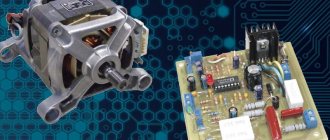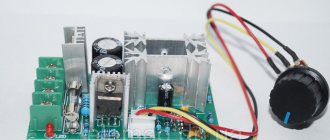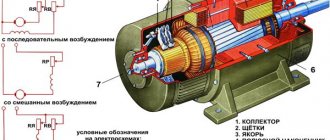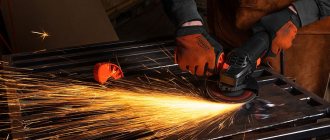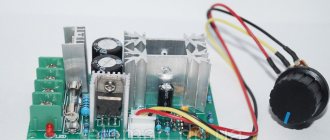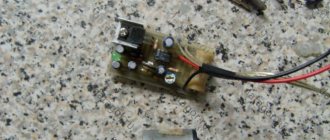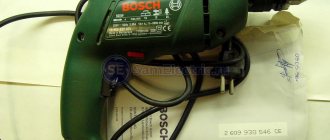home
Reading time 6 min Published 06/25/2021
Each of us has some kind of electrical appliance at home that has been working in the house for more than one year. But over time, the power of the technology weakens and does not fulfill its intended purpose. This is when you should pay attention to the insides of the equipment. Mostly problems arise with the electric motor, which is responsible for the functionality of the equipment. Then you should turn your attention to a device that regulates engine speed without reducing its power.
Types of engines
The speed control with power maintenance is an invention that will breathe new life into an electrical appliance, and it will work like a newly purchased product . But it is worth remembering that engines come in different formats and each has its own maximum performance.
The engines have different characteristics. This means that this or that technique operates at different speeds of the shaft that triggers the mechanism. The motor can be :
Mostly three-phase electric motors are found in factories or large factories. At home, single-phase and two-phase are used. This electricity is enough to operate household appliances.
Conclusion
When voltage is applied to asynchronous motor models, the rotor jerks. This phenomenon negatively affects the operation of both the unit itself and its drive. That is why the adjustment is carried out according to the principle of a smooth start. It is provided by the following factors:
- start via LATR;
- acceleration and operation of the motor by switching windings according to triangle/star circuits;
- the use of protective devices, for example, a frequency converter.
It is important when regulating the speed not to lose power. Using the methods described above will allow you to determine rotations without reducing productivity. A wide selection of factory models, but you can also implement the part yourself.
Power speed regulator
Work principles
A 220 V electric motor speed controller without loss of power is used to maintain the initial set shaft speed. This is one of the basic principles of this device, which is called a frequency regulator.
With its help, the electrical device operates at the set engine speed and does not reduce it . The engine speed controller also affects the cooling and ventilation of the motor. With the help of power, the speed is set, which can be either raised or reduced.
Many people have asked the question of how to reduce the speed of a 220 V electric motor. But this procedure is quite simple. One has only to change the frequency of the supply voltage, which will significantly reduce the performance of the motor shaft. You can also change the power supply to the motor by activating its coils. Electrical control is closely related to the magnetic field and motor slip. For such actions, they mainly use an autotransformer and household regulators, which reduce the speed of this mechanism. But it is also worth remembering that engine power will decrease.
Shaft rotation
Engines are divided into:
The speed controller of an asynchronous electric motor depends on the current connection to the mechanism. The essence of the operation of an asynchronous motor depends on the magnetic coils through which the frame passes. It rotates on sliding contacts. And when, when turning, it turns 180 degrees, then through these contacts the connection will flow in the opposite direction. This way the rotation will remain the same. But with this action the desired effect will not be obtained. It will come into force after a couple of dozen frames of this type are added to the mechanism.
The commutator motor is used very often . Its operation is simple, since the transmitted current passes directly - because of this, the power of the electric motor is not lost, and the mechanism consumes less electricity.
The washing machine motor also needs power adjustment. For this purpose, special boards were made that cope with their job: the engine speed control board from a washing machine has multifunctional use, since its use reduces the voltage, but does not lose rotation power.
The circuit of this board has been verified. All you have to do is install diode bridges and select an optocoupler for the LED. In this case, you still need to put a triac on the radiator. Basically, engine adjustment starts at 1000 rpm.
If you are not satisfied with the power regulator and its functionality is lacking, you can make or improve the mechanism . To do this, you need to take into account the current strength, which should not exceed 70 A, and heat transfer during use. Therefore, an ammeter can be installed to adjust the circuit. The frequency will be small and will be determined by capacitor C2.
Next, you should configure the regulator and its frequency. When outputting, this pulse will go out through a push-pull amplifier using transistors. You can also make 2 resistors that will serve as an output for the computer's cooling system. To prevent the circuit from burning out, a special blocker is required, which will serve as double the current value. So this mechanism will work for a long time and in the required volume. Power regulating devices will provide your electrical appliances with many years of service without special costs.
Read also: DIY jigsaw table
Smooth engine operation, without jerks or power surges, is the key to its durability. To control these indicators, an electric motor speed controller is used for 220V, 12V and 24V; all of these frequencies can be made with your own hands or you can buy a ready-made unit.
Criteria for choosing a good grinder
Disc diameter
The disc is the main consumable material for an angle grinder. He is the one who cuts, grinds, and cleans. When choosing a diameter, it is important to consider that the “useful area” of the disk, and therefore the cutting depth, is approximately four times smaller than its diameter. That is, it cuts only the outermost 1/3-1/4 of the disk. There are discs of 5 diameters:
- 115 mm is the smallest disc. It is not suitable for general cutting due to its shallow cutting depth (less than 25mm), but is good for small jobs and sanding. There are also machines with 100 mm discs designed exclusively for grinding and polishing, but they are highly specialized and not very common in everyday life.
- 125 mm is the most popular disc size for a household angle grinder with a cutting depth of about 40 mm. With discs for different purposes, it allows you to cut almost all materials;
- 150 mm is convenient for cutting concrete, brick, metal pipes;
- 180 mm will be useful for those who have started repairs or construction;
- 230 mm - discs for professional grinders with a cutting depth of up to 70 mm, rarely used for home needs. As a rule, the larger the disk that the grinder is designed for, the greater the weight of the assembled tool.
Power
It ensures stable operation of the tool under load and allows you to work for a long time without stopping to rest the tool. The power of grinders varies from 0.5 to 2.6 kW and is not strictly tied to the size of the disk, that is, you can find a machine with a 125 mm disk with a power of both 600 W and 1.5 kW. For domestic purposes, an angle grinder of 600-900 watts is sufficient. For long and complex work with heavy wheels, you should choose an option with a power of 1.5 kW or more.
Speed
Shows the rotation speed of the spindle on which the disk is installed and can be up to 7000-9000 for models with large disks and up to 12,000 rpm for models with small disks. Good grinders have a manual regulator to regulate the speed, which allows you to reduce the rotation speed if necessary.
Number of handles
The convenience and safety of work depends on this parameter. Angler grinders can be one-handed or two-handed. The first option is common among relatively light models, both household and professional. A lightweight grinder can simply be supported by the body with the other hand. Two-handed grinders are heavy professional and semi-professional models, effective and safe work with which requires physical strength and a reliable grip. It’s good if the handle/handles of any angle grinder have a rubberized coating or a vibration damping system.
Additional features
High-quality angle grinders have useful functions that make work easier and extend the life of the angle grinder. Their presence indicates the professional purpose of the instrument and significantly affects the price. They are also found in good household tools:
- “soft start” (start without jerking);
- automatic shutdown of brushes during short-term power outages;
- auto-balancing of the disk (reduces the beating of the disk during uneven erasing, and therefore vibration in the hands);
- possibility of fixing the power button for long-term operation;
- possibility of changing the casing without tools;
- automatic (electronic) control of disk rotation speed;
- improved dust protection of the stator and armature;
- dust removal system (presence of a special nozzle for connecting a construction vacuum cleaner).
Why do you need a speed controller?
An engine speed controller, a frequency converter, is a device with a powerful transistor, which is necessary to invert the voltage, as well as to ensure smooth stopping and starting of an asynchronous motor using PWM. PWM – wide-pulse control of electrical devices. It is used to create a specific sinusoid of alternating and direct current.
Photo - a powerful regulator for an asynchronous motor
The simplest example of a converter is a conventional voltage stabilizer. But the device under discussion has a much wider range of operation and power.
Frequency converters are used in any device that is powered by electrical energy. Governors provide extremely precise electrical motor control so that engine speed can be adjusted up or down, maintaining revs at the desired level, and protecting instruments from sudden revving. In this case, the electric motor uses only the energy needed to operate, instead of running it at full power.
Photo – DC motor speed controller
Why do you need a speed controller for an asynchronous electric motor:
- To save energy. By controlling the speed of the motor, the smoothness of its start and stop, strength and speed, you can achieve significant savings in personal funds. As an example, reducing speed by 20% can result in energy savings of 50%.
- The frequency converter can be used to control process temperature, pressure or without the use of a separate controller;
- No additional controller required for soft start;
- Maintenance costs are significantly reduced.
The device is often used for a welding machine (mainly for semi-automatic machines), an electric stove, a number of household appliances (vacuum cleaner, sewing machine, radio, washing machine), home heater, various ship models, etc.
Photo – PWM speed controller
Operating principle of the speed controller
The speed controller is a device consisting of the following three main subsystems:
- AC motor;
- Main drive controller;
- Drive and additional parts.
When the AC motor is started at full power, current is transferred with the full power of the load, this is repeated 7-8 times. This current bends the motor windings and generates heat that will be generated for a long time. This can significantly reduce engine longevity. In other words, the converter is a kind of step inverter that provides double energy conversion.
Photo - diagram of the regulator for a commutator motor
Depending on the incoming voltage, the frequency regulator of the speed of a three-phase or single-phase electric motor rectifies the current of 220 or 380 volts. This action is carried out using a rectifying diode, which is located at the energy input. Next, the current is filtered using capacitors. Next, PWM is generated, the electrical circuit is responsible for this. Now the windings of the induction motor are ready to transmit the pulse signal and integrate them into the desired sine wave. Even with a microelectric motor, these signals are issued, literally, in batches.
Read also: How to connect a switch with two schneider keys
Photo – regulator diagram for brushless motors
There are two parts in this circuit - one is logical, where the microcontroller is located on the chip, and the second is power. Basically, such an electrical circuit is used for a powerful electric motor.
Video: electric motor speed controller with SHIRO V2
Carrying out regulation in AC motors
Devices operating on alternating voltage also support speed control. Let us briefly consider the main methods of such control, characteristic of AC modifications with phase-wound rotors.
Using voltage
For this purpose, autotransformers of the LATR type are used, which change the voltage on the motor windings. This is how the shaft speed is controlled.
The method is also suitable for variations with squirrel cage rotors. The operator has the opportunity to carry out control within the range from minimum to nominal engine parameters.
Regulator
Definition of resistance
The variable resistance of the rheostat (or several such phenomena) is realized directly in the rotor circuit. It affects the rotor field and current indicators, which makes it possible to change the slip values and the exact number of revolutions of the electric motor. There is a pattern: the lower the current level, the higher the motor slip rate and the lower the speed.
Advantages:
- wide range of speed control of electrical equipment;
- restrained output characteristics of the machine.
The disadvantages include:
- decrease in engine productivity;
- general decrease in the operating parameters of the mechanism.
Dual power application
Motors with dual power supplied through valve fittings are used here. The main emphasis is on changing slip performance. When regulating the operation of large specialized machines, the component supplies and regulates the amount of EMF (electromotive force) to the rotor from separately selected voltage sources.
How to make a homemade engine speed controller
You can make a simple triac motor speed controller, its diagram is presented below, and the price consists only of parts sold in any electrical store.
To work, we need a powerful triac of the BT138-600 type, it is recommended by a radio engineering magazine.
Photo - do-it-yourself speed controller diagram
In the described circuit, the speed will be adjusted using potentiometer P1. Parameter P1 determines the phase of the incoming pulse signal, which in turn opens the triac. This scheme can be used both in field farming and at home. You can use this regulator for sewing machines, fans, tabletop drilling machines.
The principle of operation is simple: at the moment when the motor slows down a little, its inductance drops, and this increases the voltage in R2-P1 and C3, which in turn leads to a longer opening of the triac.
A thyristor feedback regulator works a little differently. It provides energy back into the energy system, which is very economical and profitable. This electronic device involves the inclusion of a powerful thyristor in the electrical circuit. His diagram looks like this:
Here, to supply direct current and rectify, a control signal generator, an amplifier, a thyristor, and a speed stabilization circuit are required.
Almost all household appliances and power tools use a commutator motor. Newer models of grinders, screwdrivers, hand routers, vacuum cleaners, mixers and others have engine speed control, but later models do not have this function. It is not always convenient to work with such tools and household appliances, and therefore there are speed controllers with power maintenance.
Maintaining constant speed in angle grinders - high-quality processing of any material
Contents :
Angle grinders, which are known to many as “grinders,” are an indispensable tool in construction. They are also used for repair work, in wood and metal workshops, and for many other purposes. The popularity of angle grinders has led to the emergence of a wide variety of this tool. Today there are a large number of different angle grinders with different technical characteristics and functions.
Manufacturers are trying to make angle grinders as efficient and economical as possible. To do this, they develop new functions and systems that simplify the use of the tool. In improved models, the speed support function has proven itself well. It makes it possible to reduce the number of consumables used and also improves the quality of work. When using it, the tool does not lose power.
Types of engines and operating principles
Motors are divided into three types: commutator, asynchronous and brushless. Most power tools use the first type. This electric motor has a fairly compact size. Its power is significantly higher than that of asynchronous, and the price is quite low. As for asynchronous ones, this type is mainly used in the metalworking industry, and they are also widespread in coal mines. Quite rarely they can be found in everyday life.
The brushless electric motor is used where high speeds, precise positioning and small dimensions are needed. For example, in various medical equipment, aircraft modeling. The principle of operation is quite simple. If a rectangular frame, which has an axis of rotation, is placed between the pluses of a permanent magnet, then it will begin to rotate. The direction depends on the direction of the current in the frame. This type contains an armature and a stator. The armature rotates, but the stator stands still. As a rule, there is not one frame at anchor, but 4.5 or more.
An asynchronous motor works on a different principle. Thanks to the effect of an alternating magnetic field in the stator coils, it is driven into rotation. If you delve deeper into the course of physics, you can remember that a kind of magnetic field is created around the conductor through which the current passes, causing the rotor to rotate.
The principle of operation of the brushless type is based on turning on the windings so that the magnetic fields of the stator and rotor are orthogonal to each other, and the torque is regulated by a special driver.
The figure clearly shows that in order to move the rotor it is necessary to perform the necessary commutation, but it is not possible to regulate the speed. However, the brushless motor can rev up very quickly.
Commutator motor design
A commutator motor consists of a stator and a rotor. The rotor is the part that
rotates, but the stator is stationary. Another component of the electric motor is graphite brushes, through which current flows to the armature. Depending on the configuration, Hall sensors may be present, which make it possible to smoothly start and adjust the speed. The higher the applied voltage, the higher the speed. This type can operate on either AC or DC power.
According to the classification, commutator motors can be divided into those that operate on alternating current and direct current. They can also be divided according to the type of winding excitation: motors with parallel, series and mixed (parallel-series) excitation.
Common parameters
The operating principle and general design of such power units are known to most, because when creating or modernizing a design one cannot do without knowledge in this category. The motor consists of the following key elements:
- rotor;
- stator;
- switching unit of brush-collector type.
When power is applied to the rotor and stator, magnetic fields are formed on each of them, which interact with each other. This in turn causes rotation in the rotor.
Power is supplied to this component using graphite brushes that fit tightly to the commutator lamellas. To change the direction of rotor rotation, you need to change the position of the voltage phases on one of two elements: the stator or the rotor.
The windings of these devices can receive power from sources, or be connected to each other in parallel. It is on the basis of this feature that power units are classified into parallel and sequential. The method of exciting the copper windings depends on this.
If we talk about sequential type commutator motors, then they are most often used in household electrical appliances. This is due to the fact that it is precisely this kind of excitation that makes it possible to obtain the most overload-resistant motor.
Types of adjustment
There are quite a few options for adjusting the speed . Here are the main ones:
- Power supply with adjustable output voltage.
- Factory adjustment devices that initially come with the electric motor.
- Push-button regulators and standard regulators that simply limit the voltage.
Read also: Checking the geometric accuracy of a lathe
These types of adjustments are bad because as the voltage decreases or increases, the power also drops. In some power tools this is acceptable, but, as practice shows, in most cases this is unacceptable due to a strong drop in power and, accordingly, efficiency.
The most acceptable option would be a regulator based on a triac or thyristor. Not only does such a regulator not reduce power when the voltage decreases, it also allows for smoother starting and speed control. In addition, such a scheme can be made with your own hands. Below is a picture of the speed control with power maintenance. The circuit is assembled on the basis of a BTA 41,800 V triac .
All ratings of electrical elements are indicated in the diagram . This is the circuit after assembly, it works quite stably and provides smooth adjustment of the brushed motor. When the output voltage decreases, the power does not decrease, which is a significant plus.
If desired, you can assemble the speed controller of a 220 V brushed motor with your own hands. This circuit is assembled on the basis of a VTA26-600 triac, which must first be installed on a radiator, since this element gets quite hot under load.
It is possible to connect an electric motor with a power not exceeding 4 kW to the finished circuit.
The diagram looks like this.
It can successfully cope with the adjustment of power tools such as a drill, grinder, circular saw, and jigsaw. If desired, you can use the circuit as a power regulator for heating elements, heaters, and as a dimmer. The disadvantages include the impossibility of adjusting the power of devices powered by direct current.
Which grinder manufacturer is the best?
The highest quality angle grinders are produced in Germany, the USA, and Japan. Hitachi (Japan), Bosch (Germany), Makita (Japan) are rightfully considered the leaders in the grinder market. The following brands have also proven themselves to be the best: DeWalt (USA), DWT (Switzerland), Interskol (Russia). The products of the manufacturer Sparky (Bulgaria), a pioneer in the production of angle grinders, also deserve flattering reviews. As for popularity, the top three are Interskol, Bosch and Makita. Angle grinders from these manufacturers combine low price and decent quality. Interskol grinders are especially often purchased for home use - they are a little cheaper. Domestic brands of grinders have noticeably caught up with European and Japanese ones, and if it is impossible or unwilling to spend a large amount on an angle grinder, feel free to take a Russian grinder.
DC Power Regulators
Sometimes there is a need to adjust the speed of a brushed DC motor.
If the consumer does not have a lot of power, then it is possible to connect a variable resistor in series, but then the efficiency of such a regulator will drop sharply. There are schemes with which it is possible to regulate the speed quite smoothly without reducing efficiency. Such a regulator is suitable for changing the brightness of various lamps, supply voltage not exceeding 12 V. This circuit also acts as a speed stabilizer; when the mechanical load on the shaft changes, the speed remains unchanged.
This 12V DC motor speed controller circuit is quite suitable for regulating and stabilizing the speed of motors with a current not exceeding 5 A. This circuit includes a bipolar transistor driver and a 7555 timer, which ensures stable operation and smooth regulation speed. The price of the parts is quite low, which is a definite plus. You can also assemble a 12 V electric motor speed controller with your own hands.



